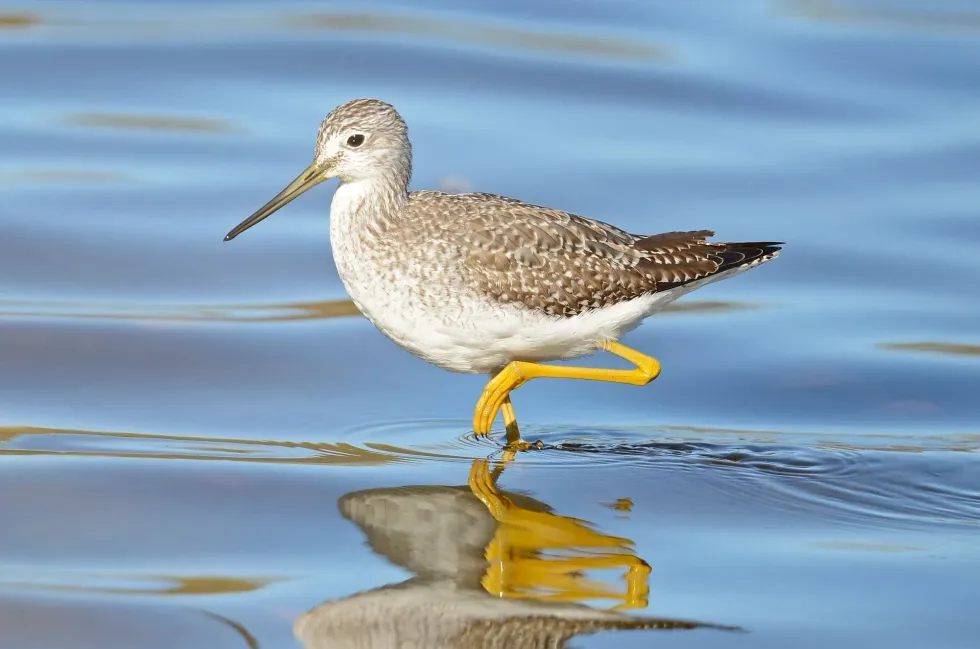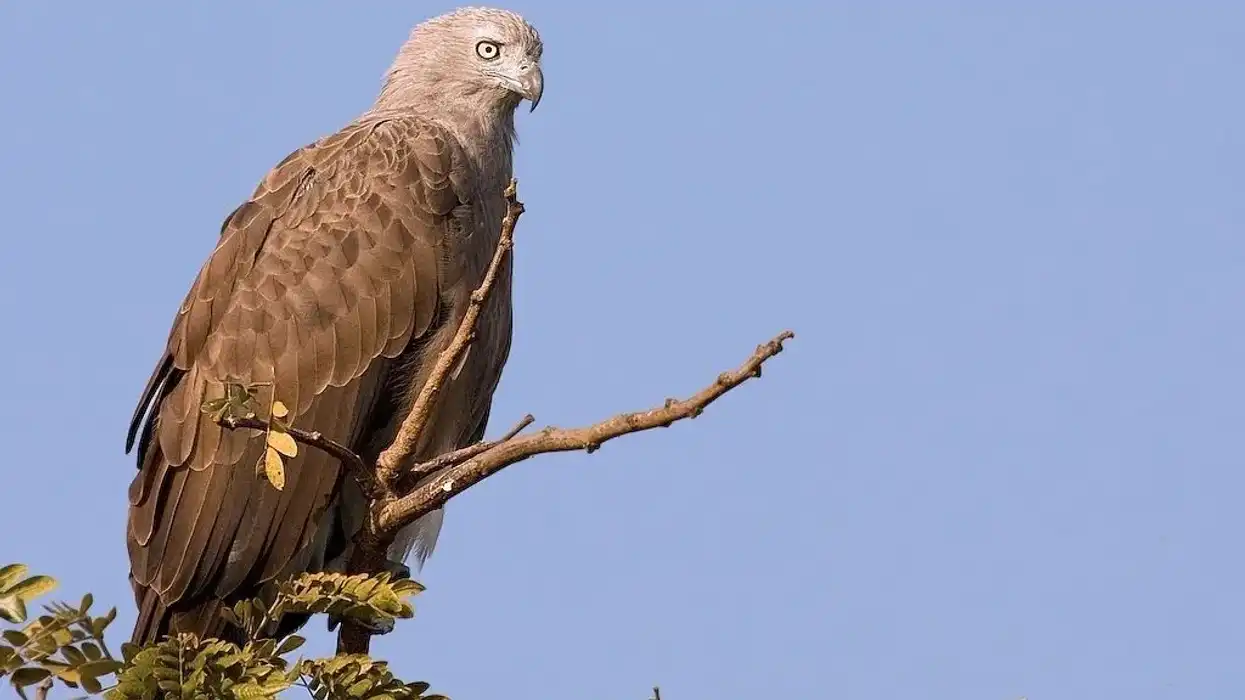Yellowlegs are a type of New World shorebird that originated in America and there are two broad subdivisions of the yellowlegs, the greater ones, and the lesser ones. The greater yellowlegs (Tringa melanoleuca), of order Charadriiformes, are found in North America commonly inhabiting the shores of large rivers, creeks, and ponds.
They have long bright yellow legs, longer than the lesser yellowlegs. The species nest near any type of aquatic marshes ranging from sewage ponds to tidal areas as well as in flooded fields.
It inhabits marshes covered in mosses and lichens. Their breeding sites are characterized by the presence of many small ponds and lakes surrounded by well-grown trees that act like perches to the birds.
Migration takes place during the winters. They eat a variety of aquatic animals that are available to them.
The loud calls are a peculiar feature of the bird. If you are interested to know more details about the greater yellowlegs, continue reading these fascinating facts.
For similar content check out the articles on the cardinal bird and the red finch.
Greater Yellowlegs Interesting Facts
What type of animal is a Greater Yellowlegs?
The greater yellowlegs (Tringa melanoleuca) are fairly large birds native to North America.
What class of animal does a Greater Yellowlegs belong to?
The shorebird greater yellowlegs are of the order Charadriiformes belong to the class Aves, which is the common class for all birds.
How many Greater Yellowlegs are there in the world?
The greater yellowlegs' population greatly decreased until the first half of the 20th century. Their decreasing population caught the attention of many wildlife enthusiasts and conservation acts were subsequently developed for them in America. Since then the population has become stable. However, the exact number of greater yellowlegs is not known.
Where does a Greater Yellowlegs live?
The shorebirds called greater yellowlegs are believed to originate in North America and inhabit areas throughout the continent. Their nesting and breeding range map covers Alaska and Canada.
The breeding grounds of the birds range from Newfoundland and the eastern part of Nova Scotia to the east of British Columbia and also in Alaska along the southern coast of the Pacific Ocean.
The breeding sites of these birds are believed to extend further in the territories of the northwest and to the south of Oregon. Migration during the winter is common in these birds.
During the harsh winter months, these birds migrate to the comparatively warmer mudflats and wetland habitats of the Pacific and Atlantic coasts. They shift their breeding grounds to the United States, Mexico, Central America, and South America in the winter.
Migration sites range from the south coast of New York like Washington and California to the Gulf of Mexico.
The vagrant population of this bird species has spread to some European countries like France, Belgium, Norway, Spain, and Denmark. Rare habitats are also located along the marshes and mudflats of Russia, South Africa, Japan, and Micronesia.
What is a Greater Yellowlegs' habitat?
The natural habitat of the greater yellowlegs includes a large range of mudflats, marshes, and wetland habitats. The bird can adapt better than other shorebirds in areas with tall vegetation owing to its long bright yellow legs.
The breeding grounds of the greater yellowlegs are found to occur in the boreal region of sluggish bogs during their breeding season with small wooded islands, as well as in coniferous forests with many wet clearings.
Subalpine scrub and subarctic tundra might also be used by these birds as their habitats during the breeding season. They move to a more general and fresh, or saline, wetland during their winter movements or migration.
The range of migrating habitats of this shorebird includes river banks, open beaches, lakeshores, and estuaries.
Due to their feeding habits, greater yellowlegs nest on the ground mostly in tidal plains or shallow lagoons as their diet mainly contains aquatic prey. In some inland farmlands in the United States or South America, the bird settles on flooded fields as well.
Who do Greater Yellowlegs live with?
Greater yellowlegs as a bird are not very social. Unlike other shorebirds, they are either found in solitude or sometimes in pairs. They feed alone in the aquatic land. However, these birds show migratory behavior and migration occurs in flocks. They form large and tight groups during migration and fly at lower altitudes.
How long does a Greater Yellowlegs live?
The lifespan of these birds is not yet known.
How do they reproduce?
The greater yellowlegs build a nest close to the ground and near water bodies. The structure of their nests looks like a moss-covered hammock and is built in a bush and shrub-covered area, preferably at the base of trees.
The greater yellowlegs pairs are monogamous and mate with a single partner for life. The male bird performs its courtship display flight to attract the females.
In its flight, the male encircles the female and poses while quivering its upheld wings. In an established pair, the display flight lasts only for seconds while for the birds trying to make a pair, the flight lasts longer.
Eventually, the male descends to the nest to breed. The greater yellowlegs produce three or four eggs per breeding season.
They only have a single brood per breeding season unless the eggs are lost. The yellowlegs form good parents.
The incubation period in this species lasts for 23 days and both parents take part in incubating the eggs by taking turns. The young birds depend on their parents for food and they learn to fly within 18-20 days.
What is their conservation status?
According to the International Union for Conservation of Nature or the IUCN, the greater yellowlegs are enlisted as a species of Least Concern. The only threat that these species are facing is habitat loss throughout their wintering range.
Greater Yellowlegs Fun Facts
What do Greater Yellowlegs look like?

The greater yellow legs are moderately tall and lanky shorebirds with a distinct pair of long bright yellow legs and a black beak. The bird appears the most striking in its breeding plumage. In its non-breeding plumage, the colors remain a bit subdued.
The head is pale and covered with light brown bands and the neck is roughly covered with grey feathers. At the back, black and white feathers form a checkerboard pattern.
Their eyes are black and are bordered by white rings. Dense black bars are present on the flanks with sparse bars along the white belly. The breeding plumage is marked by dark black bands around the chest and neck.
However, in all kinds of plumage, the bird flaunts bright yellow legs. There is no sexual dimorphism in this shorebird and both the species look the same.
The young ones have similar plumage to their parents. The upper portion of the wings is dark brown in color. The tail is also covered in black and white feathers.
How cute are they?
The lesser yellowlegs have a tender face and look very gentle. The greater ones are larger and appear harsher. However, their cuteness remains subjective and varies from person to person.
How do they communicate?
This species of bird guide other birds with its unique and peculiar calls. These strident calls are often referred to as alarm calls and are very loud. Apart from the greater yellowlegs call, they use vision and touch as other communicative measures.
How big is a Greater Yellowlegs?
The greater yellowlegs fall on the taller side. The length of the bird ranges from 11-16 in (29-40 cm). The length of the wingspan of greater yellowlegs in flight is measured at 23.6 in (60 cm). They are somewhat smaller than the marbled godwit.
How fast can a Greater Yellowlegs fly?
The greater yellowlegs are swift and strong fliers. The behavior of extending their legs beyond their tail while flying boosts their speed. The exact speed of the bird is unknown.
How much does a Greater Yellowlegs weigh?
The species of the greater yellowlegs weigh between 3.9-8.8 oz (111-250 g).
What are their male and female names of the species?
The male and the female species do not have any specific names. Both of them are together called greater yellowlegs.
What would you call a baby Greater Yellowlegs?
The babies of a bird are known as chicks or nestlings. Similarly, the babies of greater yellowlegs will also be known as nestlings or chicks.
What do they eat?
The greater yellowlegs forage in shallow water to feed on aquatic prey. Their diet mainly includes fish. Apart from fish they also feed on worms, crustaceans, and small invertebrates. It eats small animals like small fish, snails, marine worms, frogs, and also seeds. During the breeding season, their diet includes insects and their larvae.
Are they friendly?
The friendliness of the greater yellowlegs cannot be judged. They prefer to stay solitary and form monogamous pairs and mate with a single bird. Despite that, they migrate in large flocks therefore it is assumed that they also do well in groups. However, they tend to attack humans if they approach their eggs or nest.
Would they make a good pet?
It is unusual to domesticate greater yellowlegs as pets. They do well in the wild and it will be cruel to snatch them away from their natural habitat. However, they are found in many zoos all over the world where they stay under proper care.
Did you know...
The head of the greater yellowlegs shows bobbing behavior. It is a characteristic behavior of its genus where it can bob its front half of the body.
What color is a greater yellowlegs beak?
The bill of greater yellowlegs looks unique and makes them look similar to willets. The two can be identified by the yellowlegs of the former one. The greater yellowlegs species have a long and upturned bill that looks black on the upper side with a pale base.
How to tell greater and lesser yellowlegs apart?
In the wild, it is difficult to distinguish between the two species of yellowlegs, the greater yellowlegs, and the lesser yellowlegs, especially when they are spotted individually.
Apart from the obvious differences in length and weight, some other notable contrasting features in a comparison between the greater yellowlegs vs lesser yellowlegs are the differences in their bills, different types of alarm calls, and the difference in their range map.
The bill of the greater yellowlegs is larger than the lesser yellowlegs and slightly upturned.
The calls of the lesser yellowlegs are a bit softer and mellow than the harsh and loud calls of the larger ones.
The body of lesser yellowlegs looks more delicate than the compact body of the greater yellowlegs with more dark bars. The greater ones are also found in comparatively larger and open marshes than the lesser yellowlegs.
Here at Kidadl, we have carefully created lots of interesting family-friendly animal facts for everyone to discover! Learn more about some other birds including the golden masked owl and the quetzal.
You can even occupy yourself at home by drawing one of our Greater Yellowlegs coloring pages.










